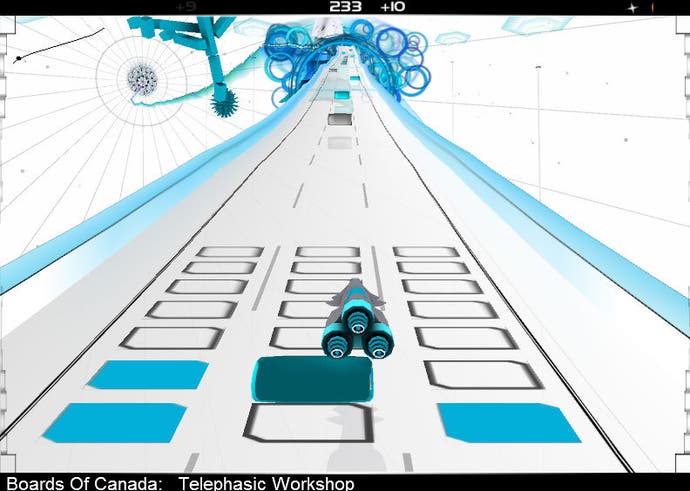Audiosurf
Lost in music?
While the world of PC gaming may be in "disarray" for those still turning out big beefy blokey shooters, for those who like to take their gaming with just a dash of indie spirit and bedroom coder verve the PC is in pretty good shape. In large part this is down to digital distribution nozzles like Steam, which allow smaller developers to get their games into our grasping paws without the need to jump through the traditional publishing hoops.
So it is for Audiosurf, which made us say nice things when it paraded around in a metaphorical swimsuit at the gamesy beauty pageant we call Independent Games Festival. We only looked at it one month ago, and yet here's the game - ready and waiting to be downloaded by anyone with USD 9.95 (or your local equivalent). So big whoops and kisses for digital distribution, and a cheeky pat on the bottom for Dylan Fitterer, the talented programmer responsible.
As those who've been paying attention will know, Audiosurf is a bit like Rez. And a bit like Amplitude. And a bit like Tetris. And a bit like Vib Ribbon. Yet rather than coming across as a gruesome mash-up of other people's ideas, it cleverly takes the best ideas from each and turns them into something that's both instantly familiar and enjoyably fresh all at the same time.

You control a vehicle speeding along an undulating track. There are three lanes, each populated by colour-coded blocks that reach the bottom of the screen in time to the music. Shoulder lanes on either side are free from blocks, allowing you to catch your breath. Superimposed on the track is a grid, seven squares down by three across. Any blocks you hit appear in the grid relative to their location. So if you pick up a red block in the right hand lane, it goes into the right-hand column of the grid. The aim is to match blocks in groups of three, which removes them from the grid and makes room for more. Allow any column to overflow, and the blocks are destroyed leaving you unable to pick up any more for a short time. Confused? Just watch a quick video and it'll become clear.
Your score depends on how many blocks you chain together, and the colour of the blocks in question. Hot reds and yellows earn the highest points per block, with blues and purples worth less. There are also score modifiers, from simple x4 multipliers to percentage bonuses for completing the course with an empty grid, or for hitting most of the red and yellow blocks along the way. It's pitched at just the right level of moreish addiction, so there's always an itching temptation to go back and see if you can improve your totals.
Audiosurf's greatest trick is that the actual content and pace of the game is completely up to the player, since it uses your MP3 collection to generate its tracks. Faster, more intense music results in terrifying downhill rushes, comparable to expert-level Guitar Hero, with blocks galore. A more chilled out musical selection will find you gently travelling uphill, with plenty of time to plan your strategy.

Unlike other rhythm games, there's no penalty for missing blocks or mucking things up. Whatever you do, you'll reach the end of every song you play - you just won't get a great score. This rather neatly leaves it up to you to decide how you want to play. If you're not fussed about being the most hardcore arcade daddy in town, the game is happy to let you find your own level of amusement without punishment.
If you want a ferocious challenge, however, there are also different ships across three difficulty levels, which mix up the gameplay in fun ways. The Vegas has the ability to shuffle the blocks on your grid into winning combinations, should you coast along the shoulder lanes for a short time. The Eraser can delete all the blocks of the next colour you hit. Control is via mouse or arrow keys, with the keyboard option shunting you from one lane to another while the mouse allows for smooth motion across the track. As the additional abilities are only available on the mouse buttons, this can lead to some awkwardness if you prefer the key method.








